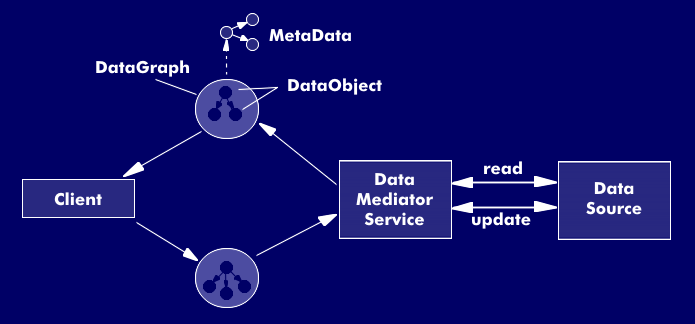service data objects (EPL, CAN) (SDO)
Service Data Objects (SDO) enable easy handling of data from different sources. The concept finds application mainly in service-oriented architectures. The motivation for SDO was to realize a unified data access layer - independent of the data sources like a database or an XML file- but without affecting the programming model.
This is how the Java Specification Request( JSR) 235 of Service Data Objects evolved, which was developed within the Java Community Process( JCP) by IBM and Bea Systems Inc. among others and first published in November 2003. In the publications SDO is also often referred to as a framework for the development of "data applications" based on a unified application programming interface( API). The reference implementation of the SDO specification 2.1.1 is the realization of the EclipseLink project. This enables Java developers to generate data and use it on a uniform basis in service architectures.
Structure of the SDO architecture
Service Data Objects were specified to realize a uniform interface (API) for the data access layer. A wide variety of technologies and models had to be taken into account. The SDO architecture defines an SDO core based on a Java environment. Among other things, the SDO core represents the interface of the framework. The central element of the SDO core is the so-called Data Mediator Service, which can be used to read or update data from any source.
The figure illustrates the interaction between a client and a data source. The data source provides the necessary data. The Data Mediator Service accesses this data and first creates a so-called data graph based on it. This describes the read data in the form of data objects and additional metadata. In order to be able to interact with different data sources, the SDO architecture implements different Data Mediator Services in each case.
The data graphs are used to represent real data as data objects and are exchanged between the communicating components. If changes are made to the data graph in a component, the structure of these changes is recorded in a summary, which is then evaluated by the Data Mediator Service in order to incorporate the changes in the original data source. Deleted, updated or new data objects are then also reflected in the summary.
The data objects can contain additional information besides the actual values or the reference to other data objects. This additional information - the metadata - can be used to analyze data. For this purpose, data objects support different mechanisms for access. Data objects can be accessed both dynamically via XPath and that data objects can be generated statically beforehand via models and schemas. Static access has the advantage that it allows simple and direct access to the data in the corresponding data graph.

